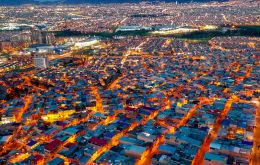MercoPress. South Atlantic News Agency
Tag: population
-
Friday, August 29th 2025 - 16:52 UTC
Brazil's population reaches 213.4 million

Brazil's Institute of Geography and Statistics (IBGE) released a study this week showing that as of July 1, 2025, the populatiin of South America's largest country aounted to 213.4 million inhabitants, representing a 0.39% increase over the previous year.
-
Friday, September 1st 2023 - 08:20 UTC
Paraguay's population below 2015 projections, census shows

Paraguay's National Institute of Statistics (INE) Thursday released its preliminary conclusions on the country's latest census, whereby the entire population would amount to 6,109,644 people (3,078,994 are men and 3,030,650 are women), thus falling noticeably short of the 2015 projections that foresaw 7,453,695 inhabitants by 2022, it was reported in Asunción. A total of 2,109,864 dwellings were counted nationwide.
-
Saturday, August 8th 2020 - 08:00 UTC
Falklands targets a 3% yearly population growth and doubles permanent residence permits

The Falkland Islands Executive Council has agreed to double the yearly quota of permanent residence permits (PRP) to 90. According to a paper published last week, the figure has been set to target a 3% yearly population growth.
-
Wednesday, July 15th 2020 - 08:03 UTC
Earth will be home to 8.8 billion people in 2100, two billion less than current UN projections

The Earth will be home to 8.8 billion people in 2100, two billion fewer than current United Nations projections, according to a major study published on Wednesday that foresees new global power alignments shaped by declining fertility rates and graying populations.
-
Saturday, September 3rd 2011 - 07:49 UTC
Almost half of foreign residents in Argentina are from Paraguay and Bolivia

Of the just over 40 million Argentines, 4.5% are foreigners, according to the latest census, and the most numerous community is made up of over half a million from neighbouring Paraguay.
-
Friday, September 2nd 2011 - 08:45 UTC
Argentina’s population stands at 40.117.096, up 10.7% from the 2001 census

Argentina has a population of 40.117.096, according to the definitive facts of the 2010 National Population and Home census released by the country’s national statistics and census bureau, Indec.
-
Thursday, September 1st 2011 - 01:21 UTC
The Brazilian population reached 192.37 million on July first

The Brazilian population grew by 1.62 million between 2010 and 2011 according to the latest data from the country’s Geography and Statistics Institute, IBGE, which means that on July first the total number of inhabitants was 192.37 million.
-
Thursday, July 28th 2011 - 20:03 UTC
EU population reached 502.5 million; Ireland, UK with highest birth rates

The population of the European Union reached 502.5 million on 1 January 2011 according to data provided by the statistical office of the European Union. This is one million and a half more than a year ago.
-
Wednesday, July 13th 2011 - 00:29 UTC
The year of the seven-billionth baby, up two billion since July 1987

The United Nations marked on Monday July 11, World Population Day, with Secretary-General Ban Ki-moon stressing that ending global poverty and inequality was the key to unleashing the great human potential for prosperity and peaceful coexistence.
-
Saturday, April 30th 2011 - 10:07 UTC
Brazilian has 190.7 million population, and 14.6 million illiterates

Brazil’s population reached 190.7 million according to primary data collected from the 2010 demographic census and released Friday by the Brazilian Geography and Statistics Institute, IBGE. The census also showed that almost 10% of the population is illiterate.
